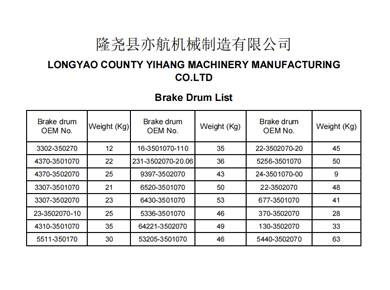Dec . 18, 2024 11:19 Back to list
brake drum skimming
Brake Drum Skimming An Essential Maintenance Procedure
When it comes to vehicle safety and performance, the braking system is one of the most crucial components. Among various parts of the braking system, the brake drum plays a pivotal role, especially in drum brake setups. Over time, brake drums can wear unevenly, leading to decreased efficiency and safety concerns. An effective way to restore them is through a process known as brake drum skimming.
What is Brake Drum Skimming?
Brake drum skimming is a machining process that involves removing a thin layer of material from the surface of a brake drum. The primary purpose of this process is to restore the drum's smoothness and ensure it is perfectly round, which is essential for optimal braking performance. Uneven wear or damage can cause vibrations, noise, and poor braking response, which poses significant safety risks. Skimming provides a cost-effective solution to extend the life of the brake drum and enhance the performance of the braking system.
When is Skimming Necessary?
There are several indicators that suggest a brake drum requires skimming. One of the most common signs is a noticeable decrease in braking performance, which may present itself as a softer pedal feel or longer stopping distances. Additionally, if a driver experiences vibrations or noises while braking, it could be due to irregularities on the brake drum surface. Furthermore, the presence of scoring or grooves on the drum—often caused by worn brake shoes or debris trapped between the drum and shoes—serves as another indicator that skimming may be necessary.
The Skimming Process
brake drum skimming

The skimming process typically takes place at a specialized automotive workshop equipped with the appropriate machinery. The brake drum is removed from the vehicle, which involves loosening and taking off the associated components. Once disassembled, the drum is inspected for significant wear, cracking, or unsalvageable damage. If deemed suitable for skimming, the drum is mounted on a lathe machine.
The lathe rotates the drum while a cutting tool gradually removes the outer layer to achieve a smooth finish. This process not only corrects deformities on the surface but also ensures that the drum is uniformly round. After skimming, it’s common practice to measure the drum’s diameter to ensure it remains within the manufacturer’s specified limits. If the drum has been excessively worn down, it may need to be replaced instead.
Benefits of Brake Drum Skimming
Skimming the brake drum yields several benefits, making it a valuable maintenance procedure. First and foremost, it enhances braking performance by restoring the drum’s surface, leading to better contact with the brake shoes. This results in improved stopping power and responsiveness. Additionally, skimming can lead to a reduction in noise and vibration during braking, enhancing the overall driving experience.
Moreover, skimming is a cost-saving measure compared to replacing the entire brake drum. It allows vehicle owners to extend the life of their existing parts, which not only saves money but also contributes to reduced waste and a more sustainable approach to vehicle maintenance.
Conclusion
In summary, brake drum skimming is a crucial maintenance procedure that helps ensure the vehicle’s braking system functions optimally. It addresses issues related to wear and damage on the brake drum, leading to enhanced safety and performance. For vehicle owners and mechanics alike, recognizing the signs that indicate the need for skimming can prevent more severe issues down the line. Regular inspection and maintenance of the braking system, including skimming when necessary, is vital for safe driving. A well-maintained braking system not only protects the driver and passengers but also contributes to the overall reliability and longevity of the vehicle. Therefore, bracing for a timely brake drum skimming can make all the difference in maintaining safe and effective vehicle operation.
-
Scania Brake Drums: OEM Quality for Optimal Safety & Durability
NewsAug.16,2025
-
R.V.I: Advanced Remote Visual Inspection for Precision
NewsAug.15,2025
-
Discover HYUNDA: Innovative Vehicles, Equipment & Solutions
NewsAug.14,2025
-
R.V.I: Unlock Advanced Insights & Real-time Performance
NewsAug.13,2025
-
Kamaz Brake Drum: Durable & Reliable for Heavy Duty Trucks
NewsAug.12,2025
-
Heavy Duty Iveco Brake Drum - Premium Quality & Safety
NewsAug.11,2025
